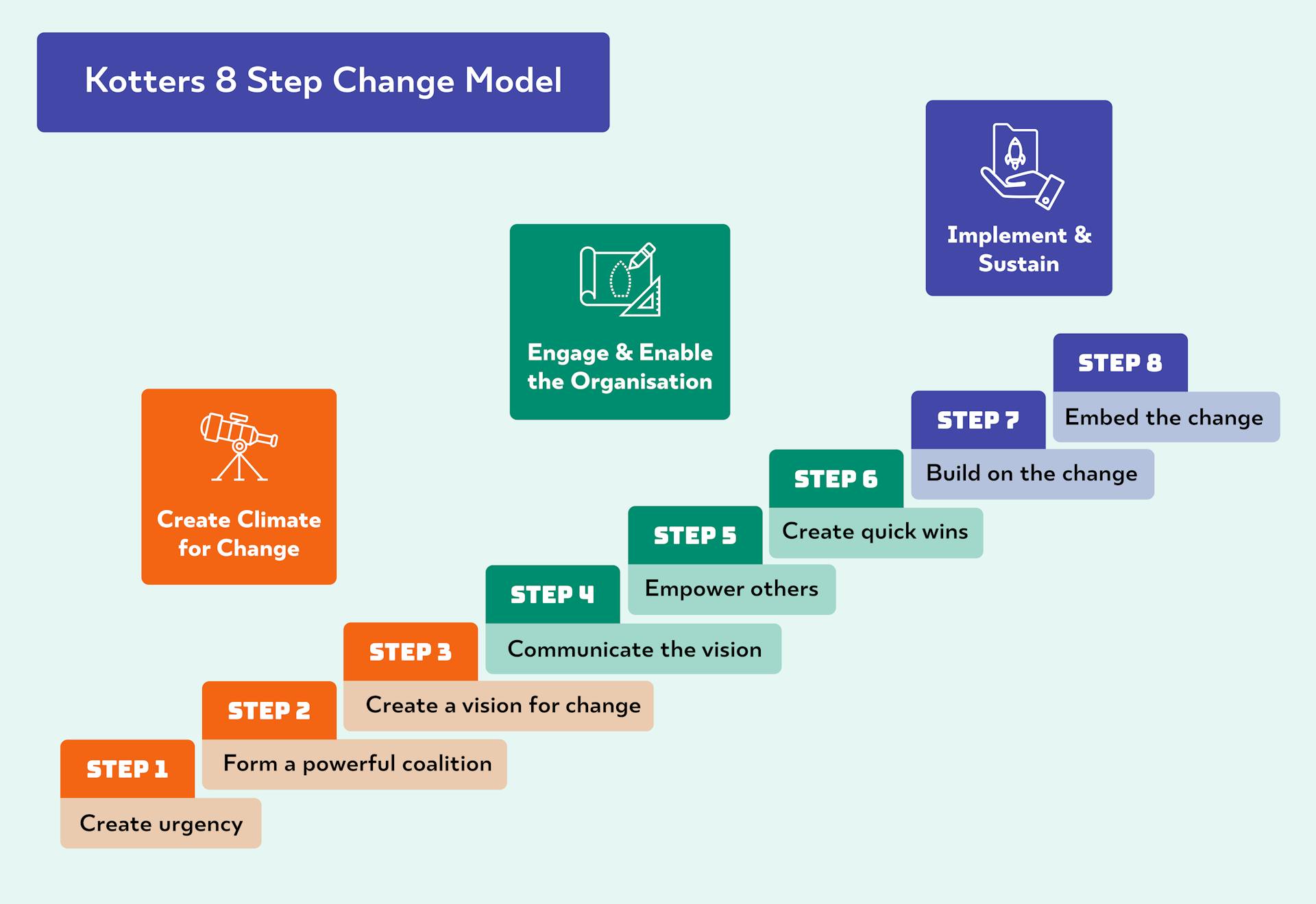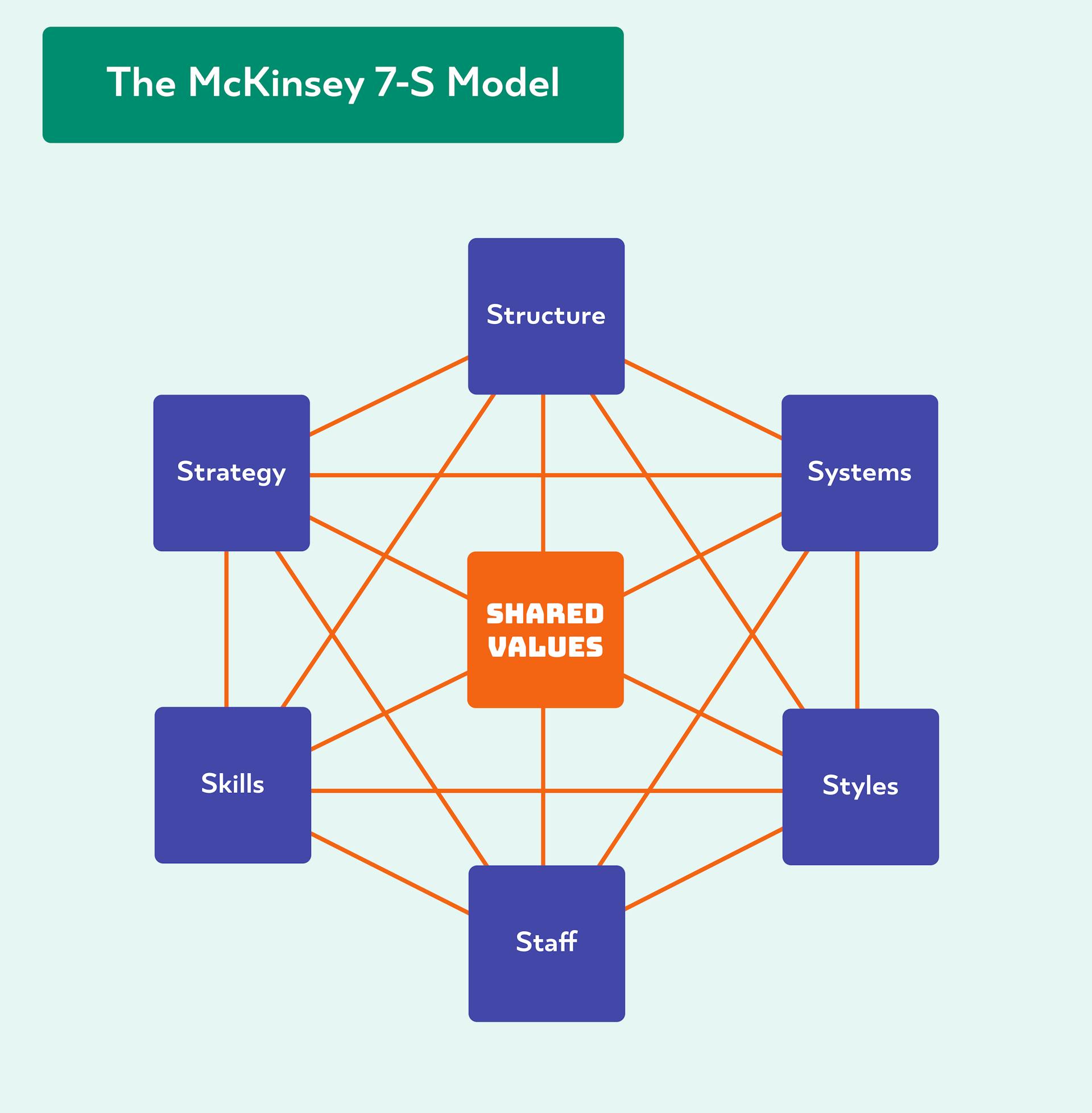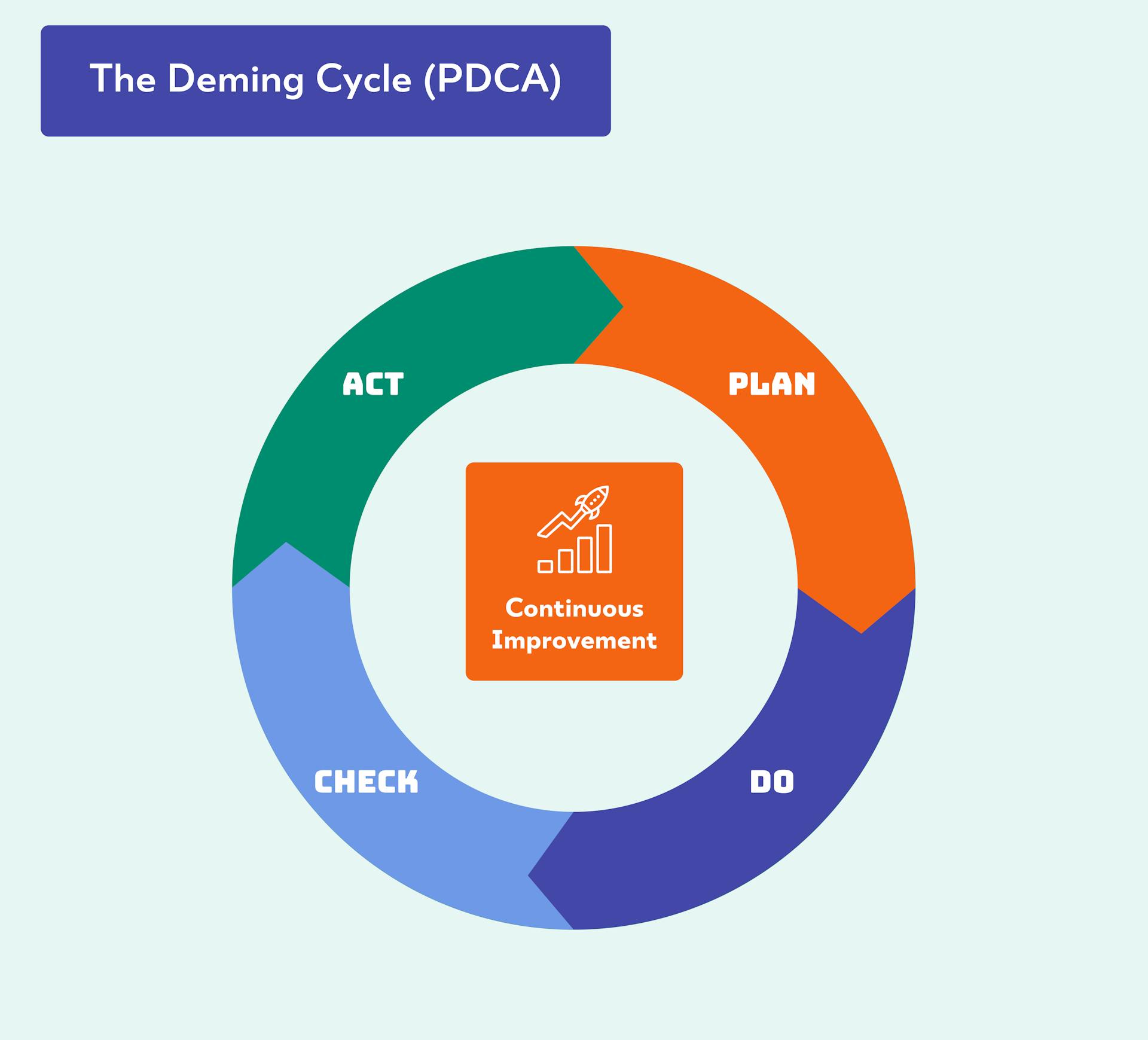Six Types Of Change Management Models for Navigating Transformation

Change has always been an inevitable aspect of doing business. New technologies pop up daily, markets constantly shift, and customers always look for the next big thing. Staying ahead of the curve isn't just a nice to have; it's essential for survival.
But let's face it: change is hard.
Even with the best intentions, change initiatives often stumble. Research from PWC shows that only about a third of these projects actually hit the mark. That's a pretty sobering statistic, and it highlights the need for a solid strategy– a change management model – to guide organisations through the twists and turns of digital transformation.
This article is your starting point for mastering the art of successful change management. We will unpack some of the most popular change management models, giving you a clear understanding of their core principles, strengths, and weaknesses.
By the end, you'll have a solid foundation for choosing the right change management framework to steer your organisation through any change that comes your way.
What is Change Management?
Change management is a roadmap for guiding companies through big changes. It's about ensuring that transitions—whether new business processes, a digital transformation, or a shift in company goals—go as smoothly as possible.
In essence, organisational change management aims to:
➡️Prepare: Assess the organisation's readiness for change, identify potential barriers, and develop strategies to overcome them.
➡️Equip: Provide employees with the necessary knowledge, skills, and resources to successfully navigate the change.
➡️Support: Guide and support individuals to adapt to new ways of working.
➡️Monitor: Track the progress of change initiatives, identify areas for improvement, and adjust as needed.

🚀Ready to Unleash Your Digital Potential?
Our extensive experience in digital transformation means we've seen it all – and we know what works. We'll leverage our deep industry knowledge to create a tailored solution that meets your specific needs and drives measurable results. Get a free proposal today.
Why change models are important
A good change management strategy helps keep things running smoothly, gets everyone on board with the changes, and shows employees why the change is a good idea. Even the most well-intentioned change initiatives fail without a proper change management process.
There are multiple change management models, each with its own strengths and weaknesses. The right change management model for your company will depend on the change you're making, your company culture, and other factors.
We'll look at a few change management processes below, breaking down how they work, their advantages, and any potential challenges they might present.
The Best Change Management Models For A Successful Implementation
Lewin's Change Management Model
This model, developed by Kurt Lewin in the 1940s, is one of the earliest organisational change management frameworks. It’s still widely used today due to its simple and intuitive nature.
It focuses on three main stages:
- Unfreeze
Prepare the organisation for change by breaking down the status quo:
- Clearly communicating why the change is necessary and how it will benefit the organisation and its employees.
- Creating a sense of urgency by highlighting the potential consequences of not changing and the opportunities that change can bring.
- Challenging existing norms by encouraging people to question their current ways of working and consider new possibilities.
- Change
Implement the new processes, systems, or behaviours by:
- Providing employees with comprehensive training and support.
- Creating a safe space for people to try new things and learn from their mistakes.
- Recognising and rewarding progress to maintain momentum and motivation.
- Refreeze
Solidify the new state as the norm by:
- Formalising new policies and procedures.
- Recognising and rewarding those who embrace the change and continue to demonstrate desired behaviours.
- Monitoring progress and adjusting as needed.

Developed by Harvard professor John Kotter, this model outlines eight critical steps for successful change:
➡️Create urgency. Help people understand why change is necessary and create a compelling reason to act now.
➡️Form a powerful coalition. Assemble a powerful team with the credibility, expertise, and leadership skills to drive the change.
➡️Create a vision for change. Develop a clear, strategic vision of the future and outline specific steps to achieve it
➡️Enlist a volunteer army. Communicate the vision widely and enthusiastically, engaging employees at all levels and encouraging their participation in the change process.
➡️Remove obstacles. Identify and eliminate obstacles to change.
➡️Create short-term wins. Celebrate small victories along the way to maintain momentum, build confidence, and reinforce the value of the change.
➡️Sustain acceleration. Don't declare victory too soon. Instead, use early successes to tackle bigger challenges. Continuously analyse what's working and what's not, and make necessary adjustments to keep the change moving forward.
➡️Anchor the changes in corporate culture. Make the change stick by embedding it into the organisation's culture. This involves reinforcing new norms and behaviours, celebrating successes, and aligning systems and processes with the desired future state.

The ADKAR model, developed by Prosci, takes a more individual-focused approach to change management. This model focuses on five stages that represent an individual's journey to implement a change.
This is not meant to be a step-by-step model; instead, each letter of the acronym is a goal that must be reached to get the desired outcome.
Here are the key principles:
➡️Awareness: This stage involves creating awareness about the need for change and its potential benefits.
➡️Desire: Cultivating a personal motivation to participate and support the change.
➡️Knowledge: This stage focuses on providing individuals with the knowledge and skills to successfully implement the change.
➡️Ability: Knowledge is not enough; individuals must also be able to apply their knowledge and skills in the new context. This stage involves providing opportunities for practice, feedback, and support to build confidence in the new processes.
➡️Reinforcement: Sustaining the change through ongoing support, recognition, and celebrating successes.

While the ADKAR model focuses on individual change, the McKinsey 7-S Model provides a broader framework for managing change across an organisation. This change management theory was introduced in the influential book "In Search of Excellence" by McKinsey & Co.
Rather than focusing solely on structure, the model emphasises the critical role of coordination and maps out a series of interconnected factors that influence a company's ability to adapt and transform.
The 7-S model identifies seven key elements, categorised as either "hard" or "soft":
Hard elements
These are typically more tangible, easily identifiable, and directly influenced by management. They include:
- Strategy: The concrete plan outlining how the organisation will compete and achieve its goals.
- Structure: The formal organisational chart and reporting relationships.
- Systems: The processes, procedures, and technologies used in daily operations.
Soft elements
These are more intangible, less easily defined, and often influenced by the organisational culture and social dynamics. They include:
- Shared values: The company's core values are evidenced in the corporate culture and the general work ethic.
- Style: The style of leadership adopted.
- Staff: The employees and their general capabilities.
- Skills: The actual skills and competencies of the employees working for the company.
This change management model highlights that change in one area often necessitates adjustments in others to maintain alignment. For example, a shift in strategy might require changes to the organisational structure, systems, or even the skills needed by employees.
Kübler-Ross Change Curve
The Kübler-Ross Change Curve, often called the "grief cycle," may sound like an unusual tool for change management. It originated from psychiatrist Elisabeth Kübler-Ross's 1969 book On Death and Dying, outlining five stages of grief:
- Denial
- Anger,
- Bargaining
- Depression
- Acceptance
While initially focused on terminally ill patients, this model surprisingly translates well to organisational change.
The reason for this is because employees don’t like change. It disrupts our familiar routines and comfort zones. The change curve expands on the grief stages to illustrate employees' emotional journey when faced with organisational shifts.
Here are the adapted stages of the change curve
➡️Shock: Initial surprise and disbelief. Productivity may dip as employees grapple with the news.
➡️Denial: A defence mechanism to avoid the reality of the change. Employee resistance and scepticism are common.
➡️Frustration: As the change becomes unavoidable, resentment and anger may surface. Communication is key here.
➡️Depression: A low point marked by disengagement and lack of motivation. This is when support systems are crucial.
➡️Experimentation: A turning point where employees tentatively begin exploring the new ways of working.
➡️Decision: Employees consciously choose to adapt and learn the new processes.
Integration: The change is fully embraced, becoming a part of the new normal. Productivity rebounds.
The model helps managers predict and prepare for the emotional roller coaster of change. Different stages require different messaging. Early on, focus on information and empathy. Later, highlight progress and successes.
While the change curve provides valuable insights into employee reactions, it doesn't offer a step-by-step implementation guide. It's best used with other change management models, like Kotter's 8-Step Process, to create a comprehensive strategy.
Satir Change Model
The Satir change management model, developed by family therapist Virginia Satir, provides a framework for understanding the emotional and behavioural stages individuals and organisations experience during times of change.
Similar to the Kübler-Ross Change Curve, the Satir change model outlines five distinct phases:
- Late status quo
The initial state of stability, where change is introduced.
- Resistance
The natural pushback against the proposed changes.
- Chaos
A period of confusion and upheaval during the implementation phase.
- Integration
A Gradual acceptance of the new reality as productivity levels out.
- New status quo
This is the final phase when the change is fully integrated into the organisation's culture and operations.
The Satir change management model provides change leaders with a framework to anticipate and address the emotional needs of their teams throughout the transition process.
By validating the resistance and chaos that naturally occur, they can create a more supportive environment that fosters acceptance and ultimately leads to a successful implementation of the new status quo.

The Bridges Transition Model focuses on the psychological transitions that individuals go through during change.
Like the Kübler-Ross Change Curve, Bridges' model emphasises the internal emotional and psychological processes people experience as they transition from the old way of doing things to the new ones.
The model's core concept is that change is imposed upon people, while transition is an active process they engage in. By anticipating the denial, anger, and frustration that often accompany change, organisations can more effectively guide individuals through the neutral zone, a crucial bridge between the old and the new.
Here are the three stages of the Bridges transition model:
1. Endings
This phase involves letting go of the old ways and practices. It can be a time of resistance and emotional turmoil as people grapple with loss and uncertainty.
2. The Neutral Zone
This is the in-between phase where the old has been left behind, but the new isn’t fully operational. It’s a period of confusion, uncertainty, and impatience, but also a time for innovation and creativity as people explore new ways of working.
3. New Beginnings
This phase marks the acceptance of the change and the beginning of new processes or behaviours. People start to embrace the new direction and develop a new sense of identity and purpose within the organisation.
The model's core concept is that change is imposed upon people, while transition is an active process they engage in. By anticipating the denial, anger, and frustration that often accompany change, organisations can more effectively guide individuals through the neutral zone, a crucial bridge between the old and the new.

The Deming Cycle, also known as the PDCA (Plan-Do-Check-Act) Cycle, is a continuous improvement model Dr. W. Edwards Deming developed.
It is a four-step iterative process designed to help organisations improve their processes, products, and services. The PDCA Cycle emphasises the importance of planning, executing, monitoring, and refining actions to achieve sustainable improvement.
Here are the four steps of the PDCA cycle:
1. Plan
Identify a goal or purpose, formulate a theory, define success metrics, and implement a plan.
Actions:
- Identify and analyse the problem or opportunity for improvement.
- Develop hypotheses about potential solutions.
- Define objectives and success criteria.
- Develop a detailed action plan, including resources, timelines, and responsibilities.
2. Do
Next, test the potential solution by implementing the plan on a small scale.
Actions:
- Execute the plan.
- Collect data on the implementation process.
- Document any issues, observations, and deviations from the plan.
- Ensure that the plan is carried out correctly and consistently.
3. Check
Review the implementation results to assess whether the plan worked as intended.
Actions:
- Analyse the collected data to evaluate the effectiveness of the solution.
- Compare the actual results with the expected outcomes.
- Identify any discrepancies or areas for further improvement.
- Determine if the problem has been resolved or if additional changes are needed.
4. Act
If the plan was successful, standardise the solution and implement it on a larger scale; if not, refine the plan and repeat the cycle.
Actions:
- Implement the successful solution on a larger scale if the results were satisfactory.
- Document the new standard procedures and processes.
- Communicate the changes to all relevant stakeholders.
- If the plan does not yield the desired results, analyse the feedback, refine the hypotheses, and restart the PDCA cycle with a revised plan.
How to Select a Change Management Framework
Now that we have discussed the most common change management models, here is a guide to selecting the right framework.
Step 1: Understand Your Change
✅Define the scope: Clearly identify the nature and extent of the change you're implementing. Is it a minor adjustment or a major transformation?
✅Identify goals: What are the desired outcomes of this change? What specific problems are you trying to solve, or improvements are you seeking?
✅Assess the impact: Who will be affected by the change and how? Consider the potential impact on individuals, teams, and the organisation.
Step 2: Consider Your Context
Selecting the right change management model involves deeply understanding your organisational context.
Consider Your Company Culture
Does your organisation value collaboration and empowerment, or is it more top-down and directive?
For instance, Kotter’s 8-Step Change Model emphasises building a guiding coalition and enlisting a volunteer army, which can be very effective in a collaborative culture.
On the other hand, a top-down culture might benefit more from the structured approach of Lewin’s Change Management Model or the McKinsey 7-S Model.
Evaluate Your Available Resources
Evaluate your financial and human resources. Some frameworks, like the McKinsey 7-S Model, require significant analysis and resource allocation, while others, like the ADKAR Model, focus more on individual readiness and can be less resource-intensive.
Stakeholder Engagement
Lastly, identify key stakeholders and their level of support for the change. Select a framework like the Bridges Transition Model and the Kübler-Ross Change Curve that addresses their concerns and actively engages them in the process. Using these frameworks can foster a sense of ownership and commitment to the desired outcomes.
Step 3: Align with Your Needs
➡️Customise: Determine if the framework can fit your needs and context. Most frameworks are adaptable, but other change management models may be more flexible than others.
➡️Integration: Assess how well the framework integrates with your existing processes and systems. Consider the potential disruption and adjust your timeline accordingly.
➡️Metrics: Define clear metrics for measuring the success of your change initiative. Choose a framework that helps you track progress and make data-driven decisions.
Step 4: Pilot and Refine
If possible, pilot the chosen framework on a smaller scale before rolling it out across the organisation. Collect feedback from participants and stakeholders to identify potential issues or improvement areas. Use those insights gained from the pilot to refine your approach and ensure a smoother implementation.
💡Keep the following in mind:
🔸No one-size-fits-all: No single "best" change management model exists. The right choice depends on your unique circumstances and goals.
🔸Hybrid approach: You can often combine elements from different frameworks to create a customised approach that suits your needs.
🔸Change is a process: Remember that change management is an ongoing process, not a one-time event. Regularly evaluate the effectiveness of your chosen framework and make adjustments as needed.
Final Thoughts
Navigating change can feel overwhelming, but the right framework can transform it from a challenge into an opportunity for growth.
Whether your organisation leans towards the structured approach of Lewin's Change Management Model, the comprehensive steps of Kotter's 8-Step Process, or another model entirely, the key is to choose one that aligns with your unique needs and culture.
Successful change isn't just about the framework, though. It hinges on meticulous planning, transparent communication, strong leadership, and unwavering support for your team.
Every change management model offers unique strengths and can be tailored to fit your circumstances, ensuring you can handle any transformation.
Ready to embrace change?
Rocketmakers can guide you through your digital transformation journey. Our expertise in change management and proven track record of success empowers organisations to navigate change confidently. We provide the tools, strategies, and support you need to turn change into a catalyst for growth.
Don't let change hold you back – let Rocketmakers turn it into a launching pad for success. Contact us today to discover how we can help you master change management and achieve your digital transformation goals.



